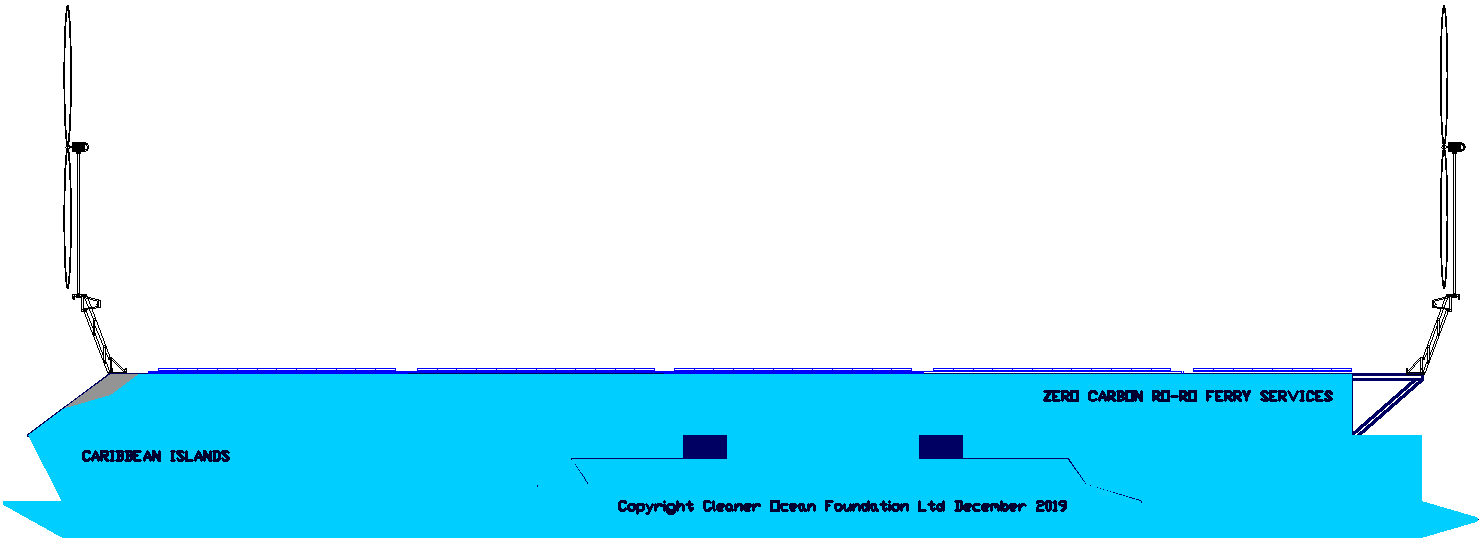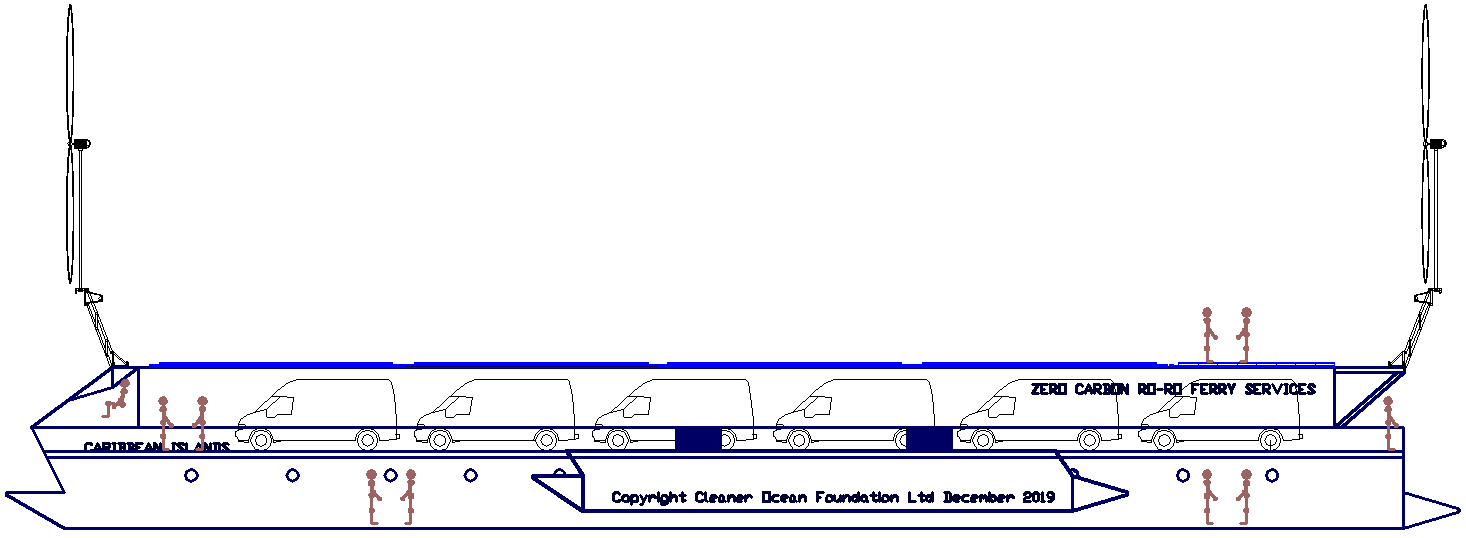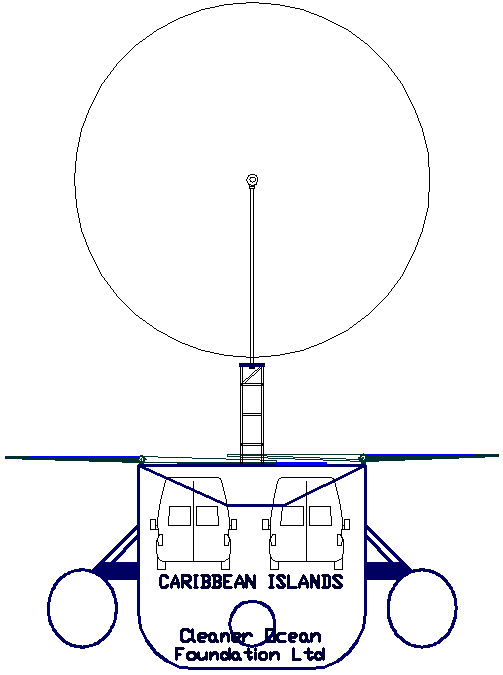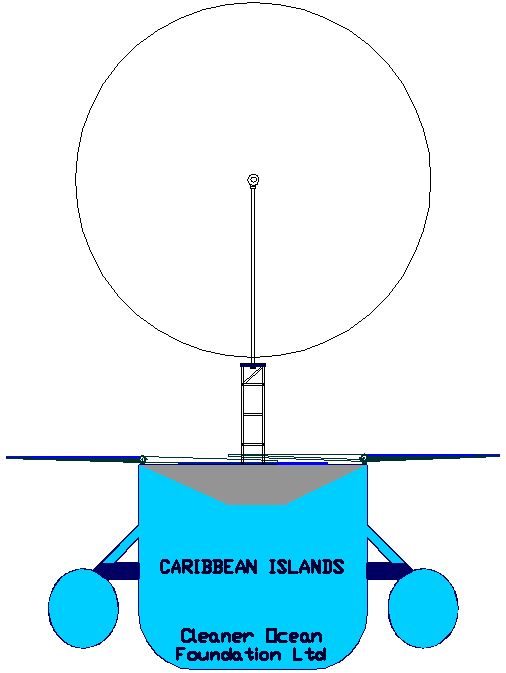|
SOLAR/WIND RORO FERRY
Please use our A-Z INDEX to navigate this site or return HOME
|
50M ZERO CARBON RORO - This is a small roll-on roll-off ferry designed to carry 12 large vans, with passenger rooms below decks. She is a zero carbon design featuring twin wind generators that also add to thrust directly from the wind (like sails) and a full deck of solar panels that track the sun - including a battery store. The age of zero carbon shipping is dawning, with designs like this leading the way. Unfortunately, this vessel would cost significantly more to build than the funding rate for this call. Hence, the proposal to develop a 16m test-bed. If the pilot vessel is successful, designs like this inter-island hopper could ensure sustainable coastal tourism - without harming planet earth. Design Copyright © December 6 2019.
Using a similar formula to the Elizabeth Swann (in convenient multiples) we envisage roll on roll off (RORO) ferries for vans, cargo and passengers, starting small - as per the 50m concept depicted on this page.
We cannot use the most efficient (circular) hullform because of the need for a relatively shallow draught, hence the drag is greater, but such a vessel should still perform reasonably well. The point being that it is a possibility, that at the time of writing nobody is looking at, in the rush to decarbonise the diesel engines in existing fleets. And who can blame the operators. The IMO could have phased in zero carbon requirements much more gradually about 20 years ago. Then there would not have been such a mad panic.
But as solar/wind shipping begins to take off, diesel, LNG and even hydrogen powered ships will not be able to compete cost wise - though such ships have the potential to be quicker. The only drawback with solar and wind powered vessels being that ships are smaller, and the consequential need for much faster turnaround times in ports and autonomous docking, if we are to carry that equivalent amount of cargo.
As we scale up to 100 meters and eventually 400 meters, the efficiency of the hull (speed/length ratio wise) increases.
But we have to start somewhere, and so for our Atlantic trials we have the 44 meter Elizabeth Swann. We have to prove that 10 knots (or thereabouts) is possible using the formula we are developing.
BLUE BONDS - In 2018, the Seychelles launched the world’s very first sovereign blue bond. That issuance was for a total of $15 million worth of 10-year bonds for the purpose of protecting marine environments and safeguarding fisheries. In September 2019 the Pacific Blue Shipping Partnership announced their intention to raise $400 million by issuing a blue bond. The coalition includes the governments of Fiji, the Marshall Islands, Samoa, Vanuatu, the Solomon Islands and Tuvalu. They have set an emissions reduction target of 40% by 2030, and full decarbonisation by 2050.
RO-RO FERRY END ELEVATION - In these drawing we see a 50 meter RoRo ferry that is designed to service tourism and deliver supplies between the Caribbean Islands. The rotary sails provide a significant area, but may be increased to improve performance. The turbines can be raised and lowered to cope with different running conditions and furled for docking in ports or during storm conditions. The main hull is not the ideal, but a compromise shallow draft design - to accommodate two Ford Transit vans side by side (12 in total). The passenger areas are below decks. The outriggers provide stability against roll induced by the wind turbines. Please note that these drawings are Design Copyright © December 6 2019, and the hull configuration and energy harvesting system are patent protected.
DRAFT SPECIFICATIONS
Material: 5083 marine alloy (substantially) Hull length:
50 meters (nominal) Navigation: COLREGS compliant autonomy AI: Onboard geospatial data harvesting system
Committees get bogged down in meeting artificial targets that are in effect increasing global warming. All they have to do is STOP making anything that is not NET ZERO. It really is that simple.
The real problem is the perceived need for continuous growth. That is in itself an artificial premise proffered by banks who want to sell you money - that the planet cannot afford. Perhaps we need a green banking revolution to accompany the forthcoming transport revolution.
|
|
Please use our A-Z INDEX to navigate this site or return HOME
This website is Copyright © 2021 Jameson Hunter Ltd
|




